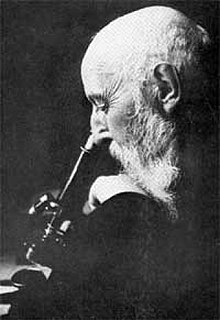Related Research Articles

Leprosy, also known as Hansen's disease (HD), is a chronic infection caused by the bacteria Mycobacterium leprae or Mycobacterium lepromatosis. Infection can lead to damage of the nerves, respiratory tract, skin, and eyes. This nerve damage may result in a lack of ability to feel pain, which can lead to the loss of parts of a person's extremities from repeated injuries or infection through unnoticed wounds. An infected person may also experience muscle weakness and poor eyesight. Leprosy symptoms may begin within one year, but, for some people, symptoms may take 20 years or more to occur.

Mycobacterium leprae, is one of the two species of bacteria that cause Hansen’s disease (leprosy), a chronic but curable infectious disease that damages the peripheral nerves and targets the skin, eyes, nose, and muscles.

Dapsone, also known as 4,4'-sulfonyldianiline (SDA) or diaminodiphenyl sulfone (DDS), is an antibiotic commonly used in combination with rifampicin and clofazimine for the treatment of leprosy. It is a second-line medication for the treatment and prevention of pneumocystis pneumonia and for the prevention of toxoplasmosis in those who have poor immune function. Additionally, it has been used for acne, dermatitis herpetiformis, and various other skin conditions. Dapsone is available both topically and by mouth.

Rifampicin, also known as rifampin, is an ansamycin antibiotic used to treat several types of bacterial infections, including tuberculosis (TB), Mycobacterium avium complex, leprosy, and Legionnaires’ disease. It is almost always used together with other antibiotics with two notable exceptions: when given as a "preferred treatment that is strongly recommended" for latent TB infection; and when used as post-exposure prophylaxis to prevent Haemophilus influenzae type b and meningococcal disease in people who have been exposed to those bacteria. Before treating a person for a long period of time, measurements of liver enzymes and blood counts are recommended. Rifampicin may be given either by mouth or intravenously.
The lepromin skin test is used to determine what type of leprosy a person is infected with. It involves the injection of a standardized extract of the inactivated "leprosy bacillus" under the skin. It is not recommended as a primary mode of diagnosis.

4-Aminosalicylic acid, also known as para-aminosalicylic acid (PAS) and sold under the brand name Paser among others, is an antibiotic primarily used to treat tuberculosis. Specifically it is used to treat active drug resistant tuberculosis together with other antituberculosis medications. It has also been used as a second line agent to sulfasalazine in people with inflammatory bowel disease such as ulcerative colitis and Crohn's disease. It is typically taken by mouth.

Clofazimine, sold under the brand name Lamprene, is a medication used together with rifampicin and dapsone to treat leprosy. It is specifically used for multibacillary (MB) leprosy and erythema nodosum leprosum. Evidence is insufficient to support its use in other conditions though a retrospective study found it 95% effective in the treatment of Mycobacterium avium complex (MAC) when administered with a macrolide and ethambutol, as well as the drugs amikacin and clarithromycin. However, in the United States, clofazimine is considered an orphan drug, is unavailable in pharmacies, and its use in the treatment of MAC is overseen by the Food and Drug Administration. It is taken orally.

Lupus vulgaris are painful cutaneous tuberculosis skin lesions with nodular appearance, most often on the face around the nose, eyelids, lips, cheeks, ears and neck. It is the most common Mycobacterium tuberculosis skin infection. The lesions may ultimately develop into disfiguring skin ulcers if left untreated.

Sweet syndrome (SS), or acute febrile neutrophilic dermatosis, is a skin disease characterized by the sudden onset of fever, an elevated white blood cell count, and tender, red, well-demarcated papules and plaques that show dense infiltrates by neutrophil granulocytes on histologic examination.

Ethionamide is an antibiotic used to treat tuberculosis. Specifically it is used, along with other antituberculosis medications, to treat active multidrug-resistant tuberculosis. It is no longer recommended for leprosy. It is taken by mouth.
Leprosy was said to be first recognized in the ancient civilizations of China, Egypt and India, according to the World Health Organization (WHO). Leprosy, also known as Hansen's disease, was officially eliminated at the national level in China by 1982, meaning prevalence is lower than 1 in 100,000. There are 3,510 active cases today. Though leprosy has been brought under control in general, the situation in some areas is worsening, according to China's Ministry of Health. In the past, leprosy sufferers were ostracized by their communities as the disease was incurable, disfiguring and wrongly thought to be highly infectious.
The Fernandez reaction is a reaction that occurs to signal a positive result in the lepromin skin test for leprosy. The reaction occurs in the skin at the site of injection if the body possesses antibodies to the Dharmendra antigen, one of the antigens found in Mycobacterium leprae, the bacteria that causes leprosy. The reaction occurs via a delayed-type hypersensitivity mechanism. This reaction occurs within 48 hours of injection of lepromin and is seen in only tuberculoid forms of leprosy. In contrast, the Mitsuda reaction occurs 3–4 weeks after injection of lepromin and is only seen in patients with the tuberculoid form of leprosy. In terms of mechanism of action and appearance, the reaction is similar to the tuberculin reaction of a positive Mantoux test for tuberculosis.

Acedapsone (INN) is an antimicrobial drug, which also has antimalarial activity.

Lepromatous leprosy is a form of leprosy characterized by pale macules in the skin.
Leprosy stigma is a type of social stigma, a strong negative feeling towards a person with leprosy relating to their moral status in society. It is also referred to as leprosy-related stigma, leprostigma, and stigma of leprosy. Since ancient times leprosy instilled the practice of fear and avoidance in many societies because of the associated physical disfigurement and lack of understanding behind its cause. Because of the historical trauma the word "leprosy" invokes, the disease is now referred to as Hansen's disease, named after Gerhard Armauer Hansen who discovered Mycobacterium leprae, the bacterial agent that causes Hansen's disease. Those who have suffered from Hansen's disease describe the impact of social stigma as far worse than the physical manifestations despite it being only mildly contagious and pharmacologically curable. This sentiment is echoed by Weis and Ramakrishna, who noted that "the impact of the meaning of the disease may be a greater source of suffering than symptoms of the disease".

Kensuke Mitsuda was a Japanese leprologist and director of the Tama Zenshoen Sanatorium (1914–1931) and the National Sanatorium Nagashima Aiseien (1931–1957). He had been at the frontier of leprosy policy of Japan. He was given the Order of Cultural Merits (1951) and Damien-Dutton Award (1961). He has been the cause of admiration from one side, and the target of criticism from the other.
Lucio's phenomenon is an unusual reaction seen almost exclusively in patients from the Caribbean and Mexico with diffuse lepromatous leprosy, especially in untreated cases. It is characterised by recurrent crops of large, sharply demarcated, ulcerative lesions, affecting mainly the lower extremities, but may generalise and become fatal as a result of secondary bacterial infection and sepsis.
The diffuse leprosy of Lucio and Latapí, also known as diffuse lepromatous leprosy or "pretty leprosy" is a clinical variety of lepromatous leprosy. It was first described by Lucio and Alvarado in 1852 and re-identified by Latapí in 1936. It is common in Mexico and in Costa Rica and very rare in other countries.

Promin, or sodium glucosulfone is a sulfone drug that was investigated for the treatment of malaria, tuberculosis and leprosy. It is broken down in the body to dapsone, which is the therapeutic form.

The history of leprosy was traced to its origins by an international team of 22 geneticists using comparative genomics of the worldwide distribution of Mycobacterium leprae. Monot et al. (2005) determined that leprosy originated in East Africa or the Near East and traveled with humans along their migration routes, including those of trade in goods and slaves. The four strains of M. leprae are based in specific geographic regions where each predominantly occurs:
References
- ↑ Definition: leprostatic from Online Medical Dictionary
- ↑ Leprostatic+agents at the US National Library of Medicine Medical Subject Headings (MeSH)
- ↑ MeSH list of agents 82007917